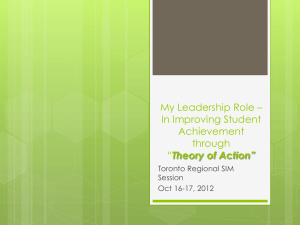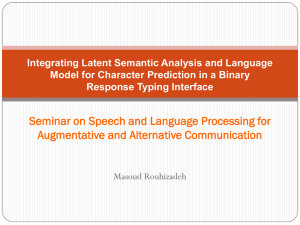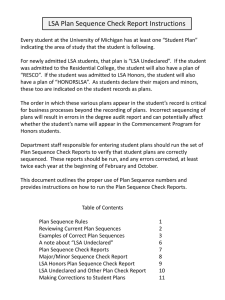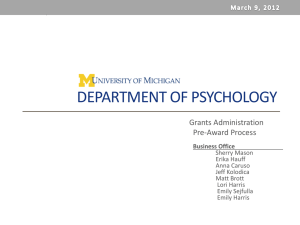Lec 5 - The Stanford NLP
advertisement
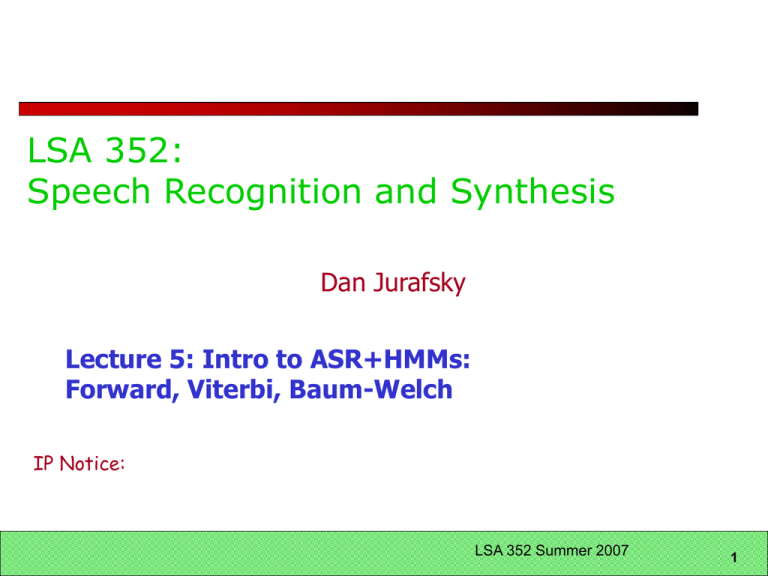
LSA 352: Speech Recognition and Synthesis Dan Jurafsky Lecture 5: Intro to ASR+HMMs: Forward, Viterbi, Baum-Welch IP Notice: LSA 352 Summer 2007 1 Outline for Today Speech Recognition Architectural Overview Hidden Markov Models in general Forward Viterbi Decoding Baum-Wlech Applying HMMs to speech How this fits into the ASR component of course July 6: Language Modeling July 19 (today): HMMs, Forward, Viterbi, Start of Baum-Welch (EM) training July 23: Feature Extraction, MFCCs, and Gaussian Acoustic modeling July 26: Evaluation, Decoding, Advanced Topics LSA 352 Summer 2007 2 LVCSR Large Vocabulary Continuous Speech Recognition ~20,000-64,000 words Speaker independent (vs. speaker-dependent) Continuous speech (vs isolated-word) LSA 352 Summer 2007 3 Current error rates Ballpark numbers; exact numbers depend very much on the specific corpus Task Digits WSJ read speech Vocabulary 11 5K Error Rate% 0.5 3 WSJ read speech Broadcast news Conversational Telephone 20K 64,000+ 64,000+ 3 10 20 LSA 352 Summer 2007 4 HSR versus ASR Task Vocab ASR Hum SR Continuous digits 11 WSJ 1995 clean 5K .5 3 .009 0.9 WSJ 1995 w/noise 5K SWBD 2004 65K 9 20 1.1 4 Conclusions: Machines about 5 times worse than humans Gap increases with noisy speech These numbers are rough, take with grain of salt LSA 352 Summer 2007 5 LVCSR Design Intuition • Build a statistical model of the speech-to-words process • Collect lots and lots of speech, and transcribe all the words. • Train the model on the labeled speech • Paradigm: Supervised Machine Learning + Search LSA 352 Summer 2007 6 Speech Recognition Architecture LSA 352 Summer 2007 7 The Noisy Channel Model Search through space of all possible sentences. Pick the one that is most probable given the waveform. LSA 352 Summer 2007 8 The Noisy Channel Model (II) What is the most likely sentence out of all sentences in the language L given some acoustic input O? Treat acoustic input O as sequence of individual observations O = o1,o2,o3,…,ot Define a sentence as a sequence of words: W = w1,w2,w3,…,wn LSA 352 Summer 2007 9 Noisy Channel Model (III) Probabilistic implication: Pick the highest prob S: Wˆ argmaxP(W | O) W L We can use Bayes rule to rewrite this: P(O |W )P(W ) ˆ W arg max P(O) W L Since denominator is the same for each candidate sentence W, we can ignore it for the argmax: Wˆ argmaxP(O |W )P(W ) W L LSA 352 Summer 2007 10 Noisy channel model likelihood prior Wˆ argmaxP(O |W )P(W ) W L LSA 352 Summer 2007 11 The noisy channel model Ignoring the denominator leaves us with two factors: P(Source) and P(Signal|Source) LSA 352 Summer 2007 12 Speech Architecture meets Noisy Channel LSA 352 Summer 2007 13 Architecture: Five easy pieces (only 2 for today) Feature extraction Acoustic Modeling HMMs, Lexicons, and Pronunciation Decoding Language Modeling LSA 352 Summer 2007 14 HMMs for speech LSA 352 Summer 2007 15 Phones are not homogeneous! 5000 0 0.48152 ay k 0.937203 Time (s) LSA 352 Summer 2007 16 Each phone has 3 subphones LSA 352 Summer 2007 17 Resulting HMM word model for “six” LSA 352 Summer 2007 18 HMMs more formally Markov chains A kind of weighted finite-state automaton LSA 352 Summer 2007 19 HMMs more formally Markov chains A kind of weighted finite-state automaton LSA 352 Summer 2007 20 Another Markov chain LSA 352 Summer 2007 21 Another view of Markov chains LSA 352 Summer 2007 22 An example with numbers: What is probability of: Hot hot hot hot Cold hot cold hot LSA 352 Summer 2007 23 Hidden Markov Models LSA 352 Summer 2007 24 Hidden Markov Models LSA 352 Summer 2007 25 Hidden Markov Models Bakis network Ergodic (fully-connected) network Left-to-right network LSA 352 Summer 2007 26 The Jason Eisner task You are a climatologist in 2799 studying the history of global warming YOU can’t find records of the weather in Baltimore for summer 2006 But you do find Jason Eisner’s diary Which records how many ice creams he ate each day. Can we use this to figure out the weather? Given a sequence of observations O, – each observation an integer = number of ice creams eaten – Figure out correct hidden sequence Q of weather states (H or C) which caused Jason to eat the ice cream LSA 352 Summer 2007 27 LSA 352 Summer 2007 28 HMMs more formally Three fundamental problems Jack Ferguson at IDA in the 1960s 1) Given a specific HMM, determine likelihood of observation sequence. 2) Given an observation sequence and an HMM, discover the best (most probable) hidden state sequence 3) Given only an observation sequence, learn the HMM parameters (A, B matrix) LSA 352 Summer 2007 29 The Three Basic Problems for HMMs Problem 1 (Evaluation): Given the observation sequence O=(o1o2…oT), and an HMM model = (A,B), how do we efficiently compute P(O| ), the probability of the observation sequence, given the model Problem 2 (Decoding): Given the observation sequence O=(o1o2…oT), and an HMM model = (A,B), how do we choose a corresponding state sequence Q=(q1q2…qT) that is optimal in some sense (i.e., best explains the observations) Problem 3 (Learning): How do we adjust the model parameters = (A,B) to maximize P(O| )? LSA 352 Summer 2007 30 Problem 1: computing the observation likelihood Given the following HMM: How likely is the sequence 3 1 3? LSA 352 Summer 2007 31 How to compute likelihood For a Markov chain, we just follow the states 3 1 3 and multiply the probabilities But for an HMM, we don’t know what the states are! So let’s start with a simpler situation. Computing the observation likelihood for a given hidden state sequence Suppose we knew the weather and wanted to predict how much ice cream Jason would eat. I.e. P( 3 1 3 | H H C) LSA 352 Summer 2007 32 Computing likelihood for 1 given hidden state sequence LSA 352 Summer 2007 33 Computing total likelihood of 3 1 3 We would need to sum over Hot hot cold Hot hot hot Hot cold hot …. How many possible hidden state sequences are there for this sequence? How about in general for an HMM with N hidden states and a sequence of T observations? NT So we can’t just do separate computation for each hidden state sequence. LSA 352 Summer 2007 34 Instead: the Forward algorithm A kind of dynamic programming algorithm Uses a table to store intermediate values Idea: Compute the likelihood of the observation sequence By summing over all possible hidden state sequences But doing this efficiently – By folding all the sequences into a single trellis LSA 352 Summer 2007 35 The Forward Trellis LSA 352 Summer 2007 36 The forward algorithm Each cell of the forward algorithm trellis alphat(j) Represents the probability of being in state j After seeing the first t observations Given the automaton Each cell thus expresses the following probabilty LSA 352 Summer 2007 37 We update each cell LSA 352 Summer 2007 38 The Forward Recursion LSA 352 Summer 2007 39 The Forward Algorithm LSA 352 Summer 2007 40 Decoding Given an observation sequence 313 And an HMM The task of the decoder To find the best hidden state sequence Given the observation sequence O=(o1o2…oT), and an HMM model = (A,B), how do we choose a corresponding state sequence Q=(q1q2…qT) that is optimal in some sense (i.e., best explains the observations) LSA 352 Summer 2007 41 Decoding One possibility: For each hidden state sequence – HHH, HHC, HCH, Run the forward algorithm to compute P( |O) Why not? NT Instead: The Viterbi algorithm Is again a dynamic programming algorithm Uses a similar trellis to the Forward algorithm LSA 352 Summer 2007 42 The Viterbi trellis LSA 352 Summer 2007 43 Viterbi intuition Process observation sequence left to right Filling out the trellis Each cell: LSA 352 Summer 2007 44 Viterbi Algorithm LSA 352 Summer 2007 45 Viterbi backtrace LSA 352 Summer 2007 46 Viterbi Recursion LSA 352 Summer 2007 47 Why “Dynamic Programming” “I spent the Fall quarter (of 1950) at RAND. My first task was to find a name for multistage decision processes. An interesting question is, Where did the name, dynamic programming, come from? The 1950s were not good years for mathematical research. We had a very interesting gentleman in Washington named Wilson. He was Secretary of Defense, and he actually had a pathological fear and hatred of the word, research. I’m not using the term lightly; I’m using it precisely. His face would suffuse, he would turn red, and he would get violent if people used the term, research, in his presence. You can imagine how he felt, then, about the term, mathematical. The RAND Corporation was employed by the Air Force, and the Air Force had Wilson as its boss, essentially. Hence, I felt I had to do something to shield Wilson and the Air Force from the fact that I was really doing mathematics inside the RAND Corporation. What title, what name, could I choose? In the first place I was interested in planning, in decision making, in thinking. But planning, is not a good word for various reasons. I decided therefore to use the word, “programming” I wanted to get across the idea that this was dynamic, this was multistage, this was time-varying I thought, lets kill two birds with one stone. Lets take a word that has an absolutely precise meaning, namely dynamic, in the classical physical sense. It also has a very interesting property as an adjective, and that is its impossible to use the word, dynamic, in a pejorative sense. Try thinking of some combination that will possibly give it a pejorative meaning. Its impossible. Thus, I thought dynamic programming was a good name. It was something not even a Congressman could object to. So I used it as an umbrella for my activities.” Richard Bellman, “Eye of the Hurrican: an autobiography” 1984. Thanks to Chen, Picheny, Eide, Nock LSA 352 Summer 2007 48 HMMs for Speech We haven’t yet shown how to learn the A and B matrices for HMMs; we’ll do that later today or possibly on Monday But let’s return to think about speech LSA 352 Summer 2007 49 Reminder: a word looks like this: LSA 352 Summer 2007 50 HMM for digit recognition task LSA 352 Summer 2007 51 The Evaluation (forward) problem for speech The observation sequence O is a series of MFCC vectors The hidden states W are the phones and words For a given phone/word string W, our job is to evaluate P(O|W) Intuition: how likely is the input to have been generated by just that word string W LSA 352 Summer 2007 52 Evaluation for speech: Summing over all different paths! f f f f f f ay ay ay ay v v v v f ay ay ay ay v v v f f f ay ay ay ay v f ay ay ay ay ay ay v f ay ay ay ay ay ay ay ay v f ay v v v v v v v LSA 352 Summer 2007 53 The forward lattice for “five” LSA 352 Summer 2007 54 The forward trellis for “five” LSA 352 Summer 2007 55 Viterbi trellis for “five” LSA 352 Summer 2007 56 Viterbi trellis for “five” LSA 352 Summer 2007 57 Search space with bigrams LSA 352 Summer 2007 58 Viterbi trellis with 2 words and uniform LM LSA 352 Summer 2007 59 Viterbi backtrace LSA 352 Summer 2007 60 LSA 352 Summer 2007 61 Evaluation How to evaluate the word string output by a speech recognizer? LSA 352 Summer 2007 62 Word Error Rate Word Error Rate = 100 (Insertions+Substitutions + Deletions) -----------------------------Total Word in Correct Transcript Aligment example: REF: portable **** PHONE UPSTAIRS last night so HYP: portable FORM OF STORES last night so Eval I S S WER = 100 (1+2+0)/6 = 50% LSA 352 Summer 2007 63 NIST sctk-1.3 scoring softare: Computing WER with sclite http://www.nist.gov/speech/tools/ Sclite aligns a hypothesized text (HYP) (from the recognizer) with a correct or reference text (REF) (human transcribed) id: (2347-b-013) Scores: (#C #S #D #I) REF: was an engineer HYP: was an engineer Eval: 9 3 1 2 SO I i was always with **** **** MEN UM and they ** AND i was always with THEM THEY ALL THAT and they D S I I S S LSA 352 Summer 2007 64 Sclite output for error analysis CONFUSION PAIRS 1: 2: 3: 4: 5: 6: 7: 8: 9: 10: 11: 12: 13: 14: 15: 16: 6 6 5 4 4 4 4 3 3 3 3 3 3 3 3 3 -> -> -> -> -> -> -> -> -> -> -> -> -> -> -> -> Total With >= (972) 1 occurances (972) (%hesitation) ==> on the ==> that but ==> that a ==> the four ==> for in ==> and there ==> that (%hesitation) ==> and (%hesitation) ==> the (a-) ==> i and ==> i and ==> in are ==> there as ==> is have ==> that is ==> this LSA 352 Summer 2007 65 Sclite output for error analysis 17: 18: 19: 20: 21: 22: 23: 24: 25: 26: 27: 28: 29: 30: 31: 32: 33: 34: 3 3 3 3 3 2 2 2 2 2 2 2 2 2 2 2 2 2 -> it ==> that -> mouse ==> most -> was ==> is -> was ==> this -> you ==> we -> (%hesitation) ==> -> (%hesitation) ==> -> (%hesitation) ==> -> (%hesitation) ==> -> a ==> all -> a ==> know -> a ==> you -> along ==> well -> and ==> it -> and ==> we -> and ==> you -> are ==> i -> are ==> were it that to yeah LSA 352 Summer 2007 66 Better metrics than WER? WER has been useful But should we be more concerned with meaning (“semantic error rate”)? Good idea, but hard to agree on Has been applied in dialogue systems, where desired semantic output is more clear LSA 352 Summer 2007 67 Summary: ASR Architecture Five easy pieces: ASR Noisy Channel architecture 1) Feature Extraction: 39 “MFCC” features 2) Acoustic Model: Gaussians for computing p(o|q) 3) Lexicon/Pronunciation Model • HMM: what phones can follow each other 4) Language Model • N-grams for computing p(wi|wi-1) 5) Decoder • Viterbi algorithm: dynamic programming for combining all these to get word sequence from speech! LSA 352 Summer 2007 68 ASR Lexicon: Markov Models for pronunciation LSA 352 Summer 2007 69 Summary Speech Recognition Architectural Overview Hidden Markov Models in general Forward Viterbi Decoding Hidden Markov models for Speech Evaluation LSA 352 Summer 2007 70


